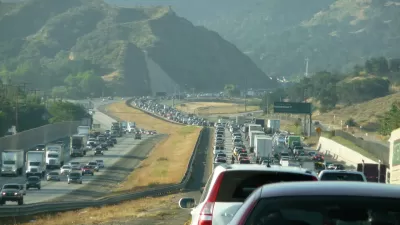There is good news in the most recent Federal Highway Administration Travel Trends report—if you look hard enough.

Vehicle miles traveled (VMT) has been on the rise since 2013, and accelerated after gas prices began falling in July 2014, with 2015 breaking the so-called "peak car" record set in 2007. [See Planetizen blog post, "So Much for Peak VMT," by Steve Polzin, March 8, 2016]
VMT "increased 1.5 percent in year-over-year comparisons or by an additional 15.2 billion miles driven in the first four months of 2017," notes the AASHTO Journal report on the FHWA data which covers preliminary traffic information from January through April of this year.
However, the rate of increase slowed in comparison to the 2.8 percent mileage increase in all of 2016 compared to 2015. Furthermore, the increase in April alone dropped to 1.2 percent compared to mileage from April 2016—that's a 57 percent reduction from the 2016 annual increase.
An increase in driving, resulting from low oil prices and a robust economy, was one factor that caused California, despite its wide array of climate change programs, to see its greenhouse gas emissions to drop by a mere 0.3 percent in 2015 notwithstanding significant reductions achieved in electricity generation due to increased use of renewable energy.
And oil prices continue to remain low, reports Steven Mufson for The Washington Post.
[G]asoline prices are hitting lows at the start of the summer driving season, a time when increased demand typically bumps up the cost of gas. This year, however, for the week that ended June 19, the nationwide average price of regular gasoline was $2.32 a gallon, about the same as June 2000 when adjusted for inflation
According to the California Air Resources Board's 2015 Greenhouse Gas Emissions Inventory released earlier this month (and posted here), greenhouse gas emissions from the transportation sector, the state’s largest source of greenhouse gases with 39 percent of statewide emissions, increased 3 percent in 2015 due to increased fuel consumption."
California and the West saw the greatest regional increase in driving, 2.4 percent, in the April FHWA report (compared to April 2016), while the Northeast experienced the least at 0.3 percent.
Hat tip to L.A. Transportation Headlines.
FULL STORY: U.S. Roadway Traffic Continues Rising to New Record Highs, Adding Pressure on Infrastructure

Trump Administration Could Effectively End Housing Voucher Program
Federal officials are eyeing major cuts to the Section 8 program that helps millions of low-income households pay rent.

Planetizen Federal Action Tracker
A weekly monitor of how Trump’s orders and actions are impacting planners and planning in America.

Ken Jennings Launches Transit Web Series
The Jeopardy champ wants you to ride public transit.

‘Smart Surfaces’ Policy Guide Offers Advice for Building and Maintaining Urban Tree Canopies
Healthy, robust tree canopies can reduce the impacts of extreme heat and improve air quality.

New Jersey Lawsuit Targets Rent-Setting Algorithms
The state of New Jersey is taking legal action against landlords and companies that engage in what the state’s Attorney General alleges is illegal rent fixing.

Washington Legislature Passes Rent Increase Cap
A bill that caps rent increases at 7 percent plus inflation is headed to the governor’s desk.
Urban Design for Planners 1: Software Tools
This six-course series explores essential urban design concepts using open source software and equips planners with the tools they need to participate fully in the urban design process.
Planning for Universal Design
Learn the tools for implementing Universal Design in planning regulations.
Heyer Gruel & Associates PA
Ada County Highway District
Institute for Housing and Urban Development Studies (IHS)
City of Grandview
Harvard GSD Executive Education
Toledo-Lucas County Plan Commissions
Salt Lake City
NYU Wagner Graduate School of Public Service





























